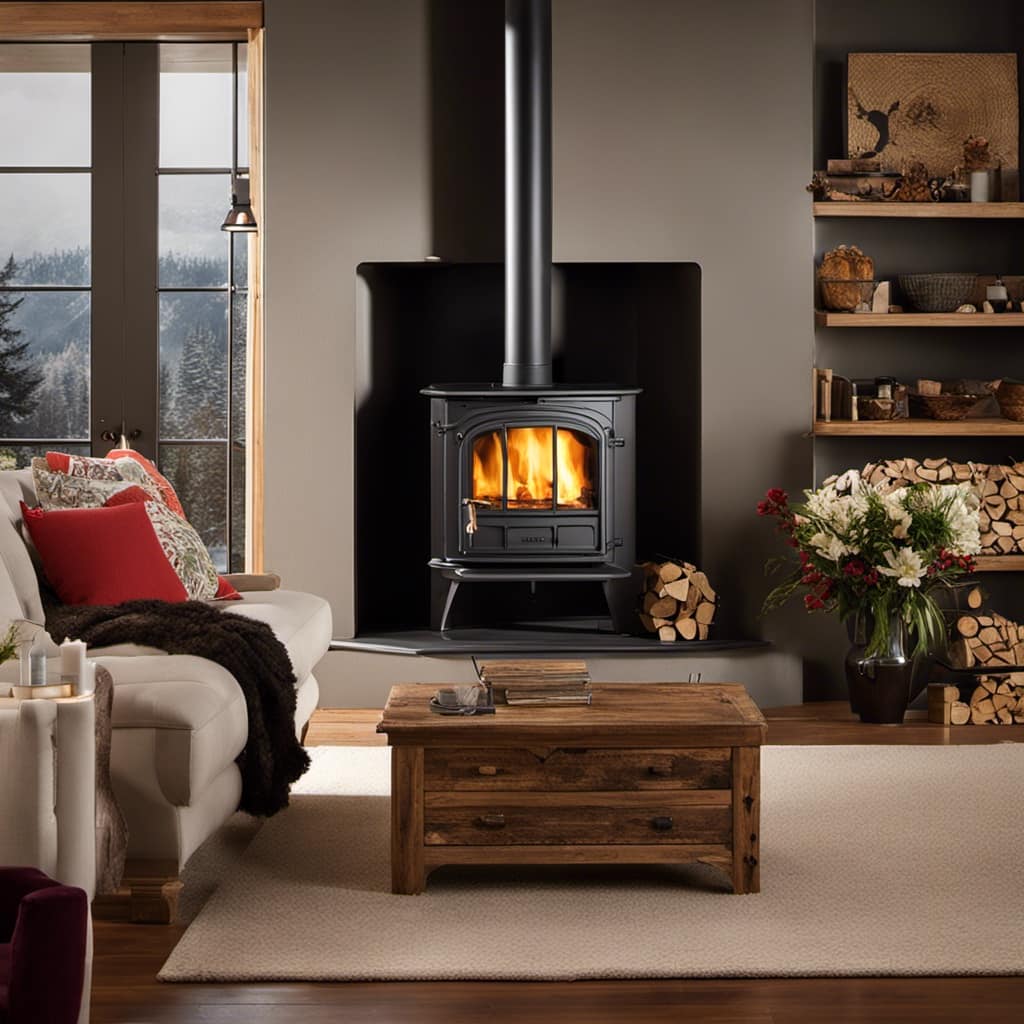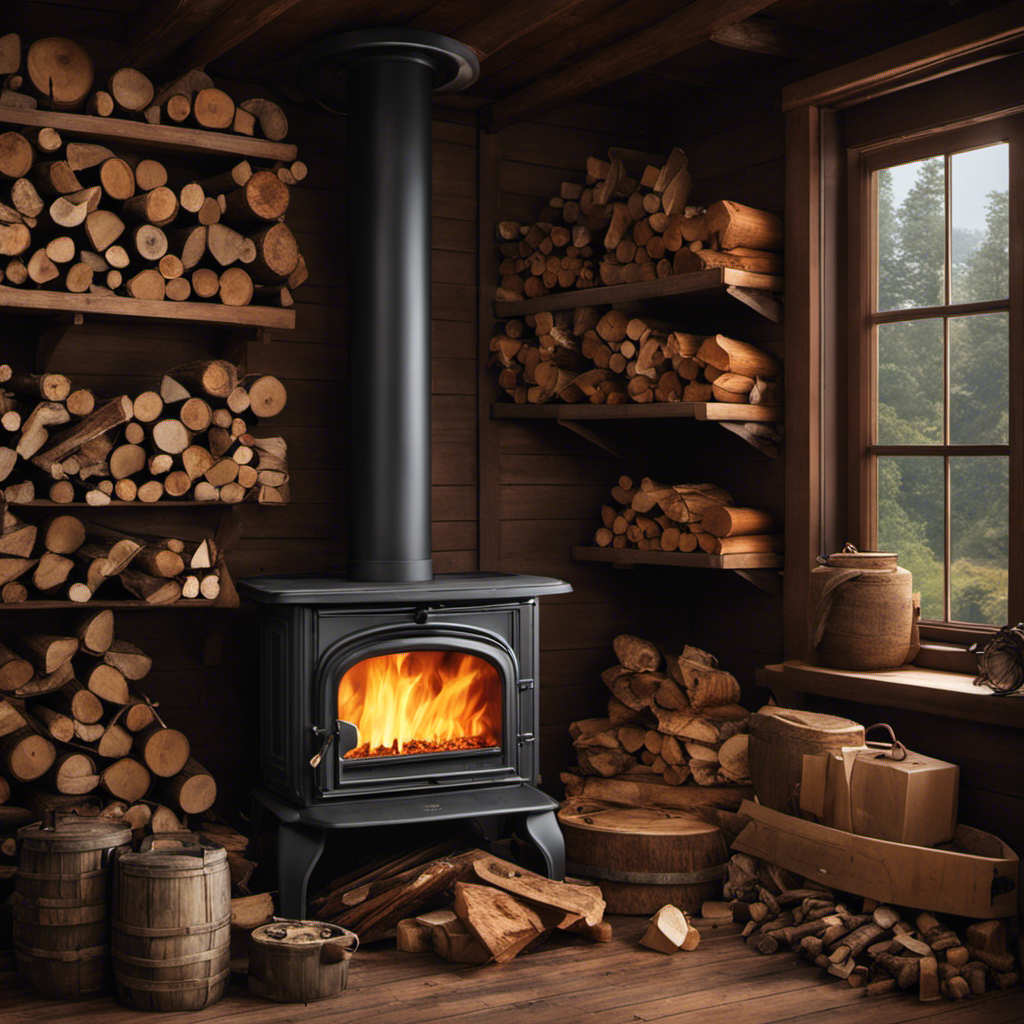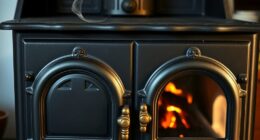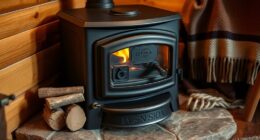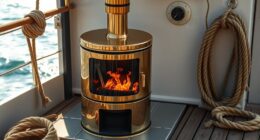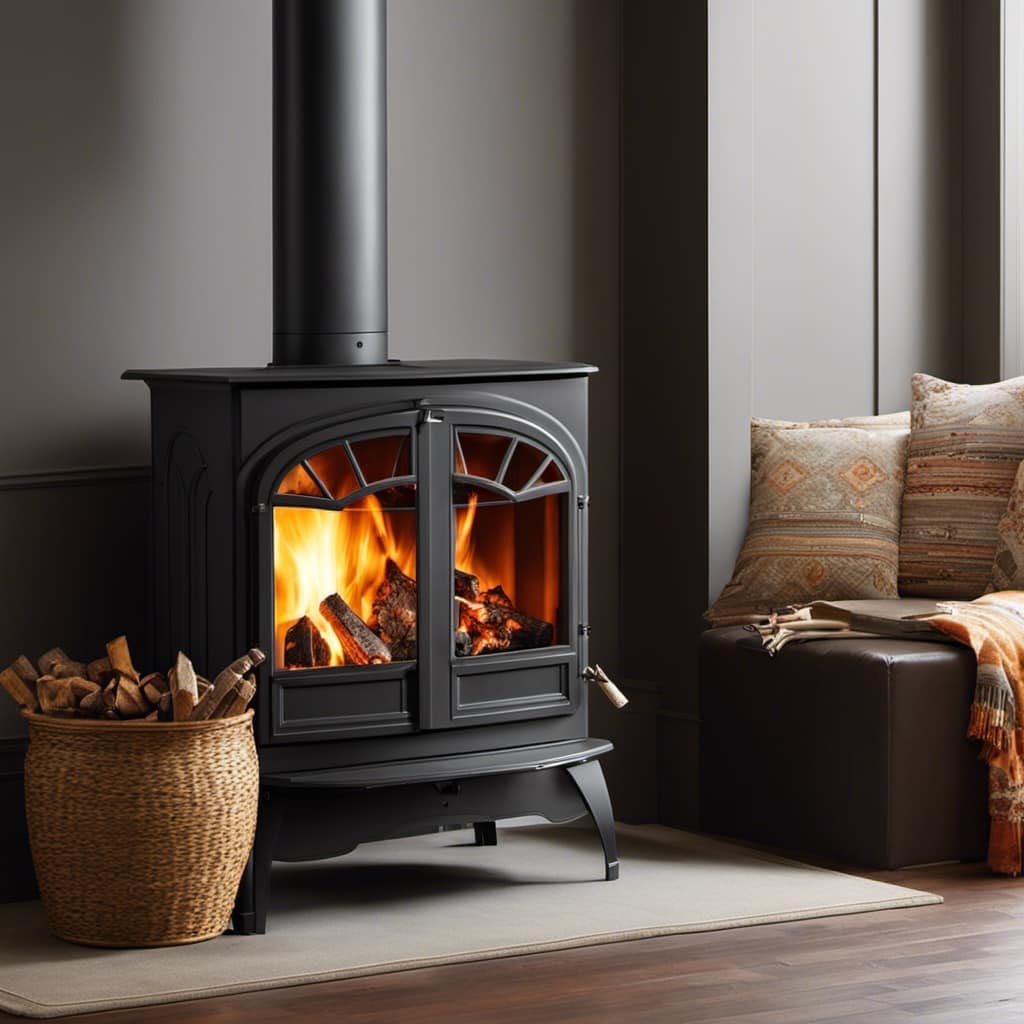
Were you aware that utilizing a wood stove to heat your house could reduce your heating expenses by as much as 30%?
In this article, I will guide you through the process of effectively using a wood stove to heat your home.
From selecting the right wood to understanding temperature control and ventilation, I will provide you with all the necessary information to maximize the efficiency and safety of your wood stove.
Let’s get started!
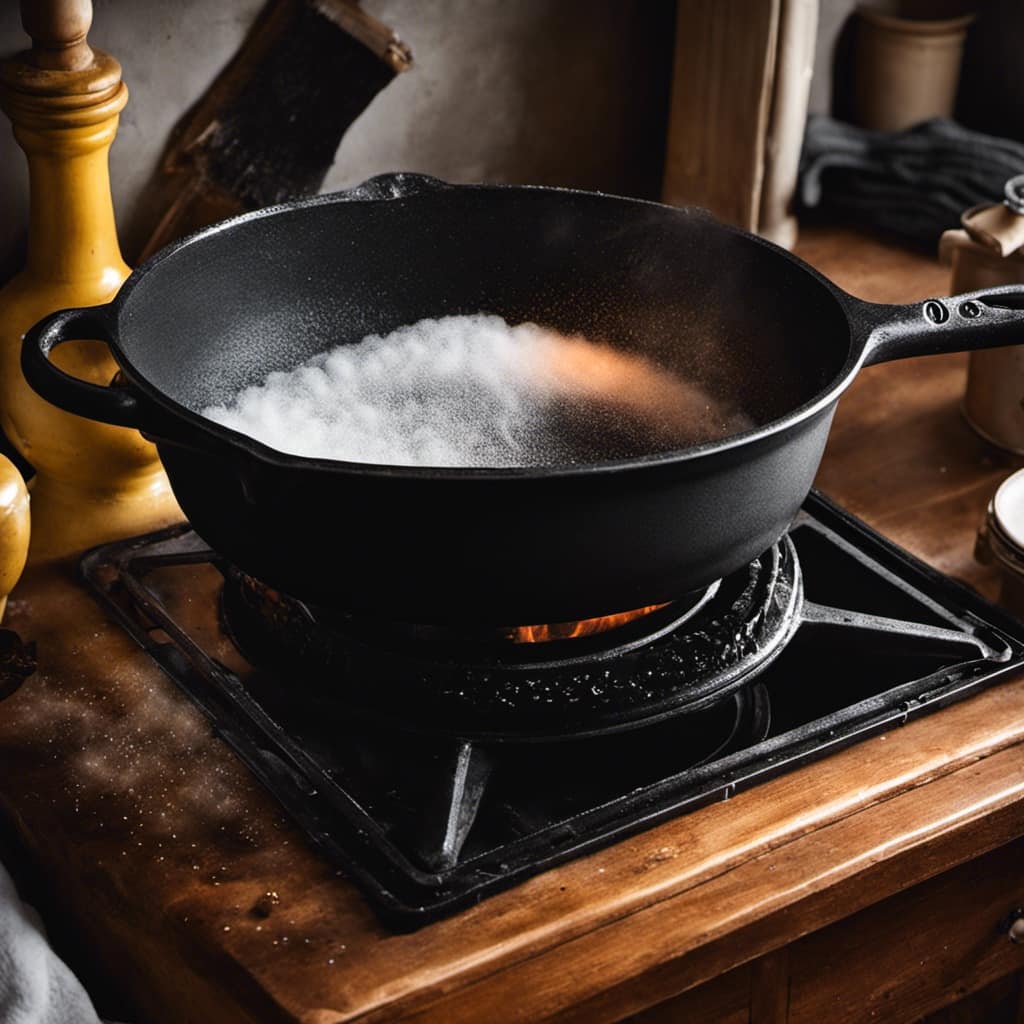
Key Takeaways
- Select wood with low moisture content for efficient burning and maximum heat output.
- Monitor and control the temperature inside your home using a thermometer, air intake, and flue pipe damper.
- Ensure proper ventilation to maintain combustion and prevent the build-up of harmful gases.
- Regularly maintain and clean your wood stove to optimize its performance and prevent safety hazards.
Selecting the Right Wood for Your Wood Stove
I find it important to choose the right type of wood for my wood stove in order to maximize efficiency and heat output. When it comes to firewood selection, one of the key factors to consider is the moisture content. Wood with high moisture content can be difficult to burn and doesn’t produce as much heat. It also creates more smoke and can lead to creosote buildup in the chimney.
Ideally, the moisture content of firewood should be below 20%. To ensure this, it’s recommended to properly season the wood by allowing it to dry for at least 6-12 months. Hardwoods such as oak, maple, and birch are great choices as they’ve a higher energy content and burn longer, providing more sustained heat.
Softwoods like pine can be used as well, but they burn faster and produce less heat. By carefully selecting firewood with low moisture content, you can maximize the efficiency and heat output of your wood stove.
Understanding Temperature Control on Your Wood Stove
When adjusting the temperature control on my wood stove, I find it helpful to start with a low setting and gradually increase it until the desired heat level is reached. Here are some temperature control techniques and troubleshooting tips to ensure efficient heating:
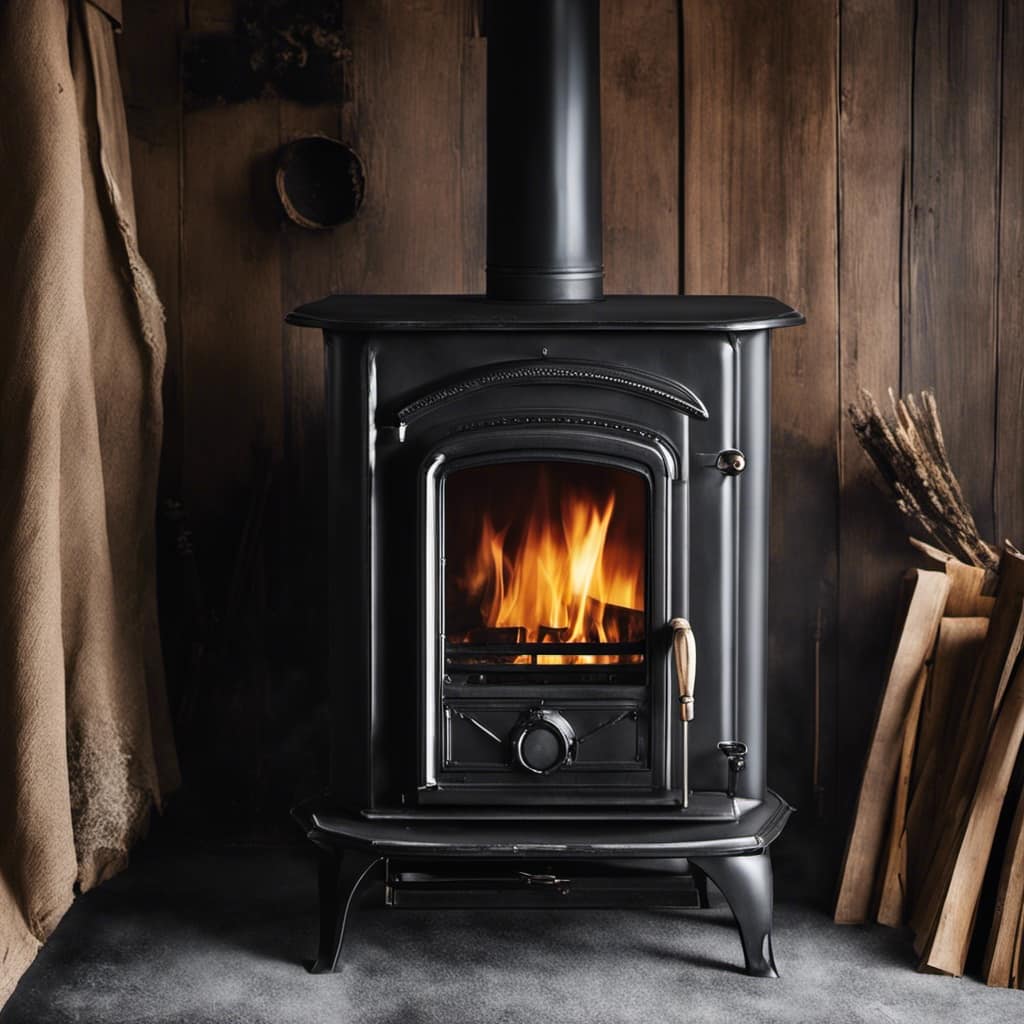
-
Monitor the temperature: Use a thermometer to keep track of the temperature inside your home. This will help you determine if the stove is producing enough heat or if adjustments are needed.
-
Adjust the air intake: The air intake controls the amount of oxygen that reaches the fire. Opening it wider will increase the heat output, while closing it will decrease it.
-
Use the damper: The damper is located in the flue pipe and controls the flow of exhaust gases. Adjusting it can help regulate the temperature and prevent excessive heat loss.
-
Check for leaks: Inspect the stove and chimney for any leaks or cracks that may cause temperature fluctuations. Proper insulation and sealing can help maintain a consistent temperature.
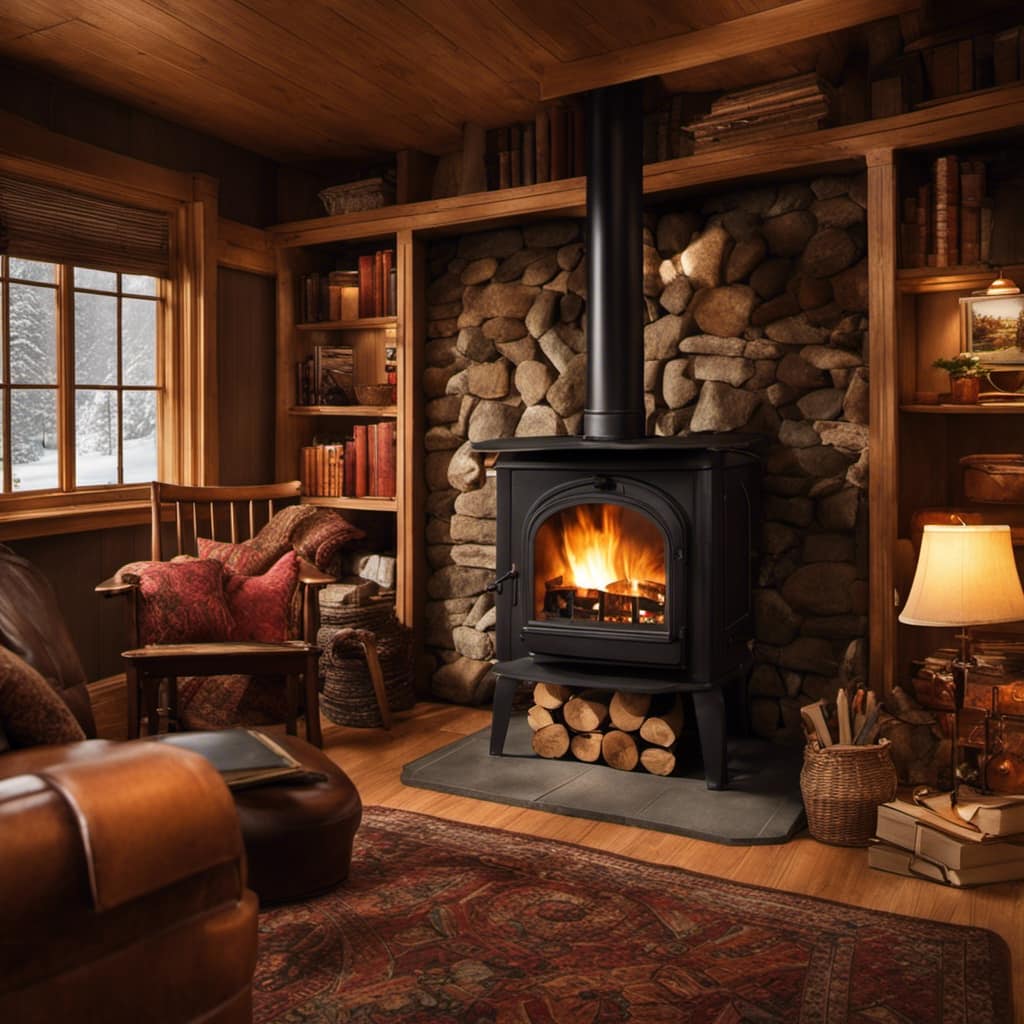
By following these temperature control techniques and troubleshooting tips, you can ensure optimal heating efficiency.
Now, let’s move on to the next section about ensuring proper ventilation for efficient heating.
Ensuring Proper Ventilation for Efficient Heating
Proper ventilation is essential for maintaining efficient heating in my home. When using a wood stove to heat my house, it’s important to ensure that there’s a constant flow of fresh air to support combustion and prevent the build-up of harmful gases.
To achieve this, I employ energy-saving techniques that promote effective air circulation. Firstly, I make sure to open a window or door slightly to allow for the intake of fresh air. This not only ensures a steady supply of oxygen but also helps to prevent drafts that can disrupt the combustion process.
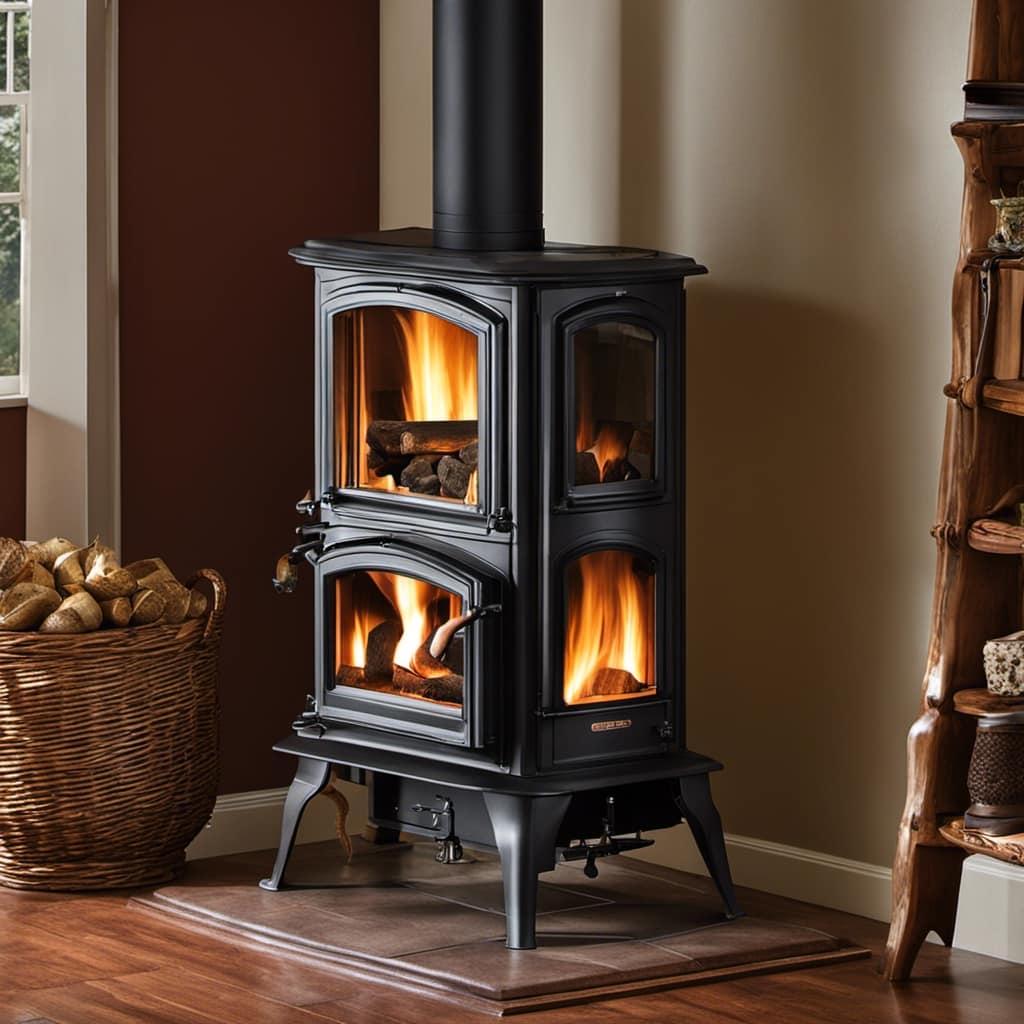
Additionally, I use a fan or ceiling fan to circulate the heated air throughout the room, promoting even distribution and reducing the need for excessive burning.
Maintaining and Cleaning Your Wood Stove for Optimal Performance
To optimize performance, regular cleaning and maintenance of my wood stove is crucial. Here are four important cleaning techniques and common maintenance issues to keep in mind:
-
Ash Removal: After each use, I carefully remove the ashes from the stove. This prevents ash buildup, which can restrict airflow and reduce efficiency.
-
Chimney Cleaning: Regularly inspect and clean the chimney to remove creosote buildup. Creosote is a byproduct of burning wood that can lead to chimney fires if left unchecked.
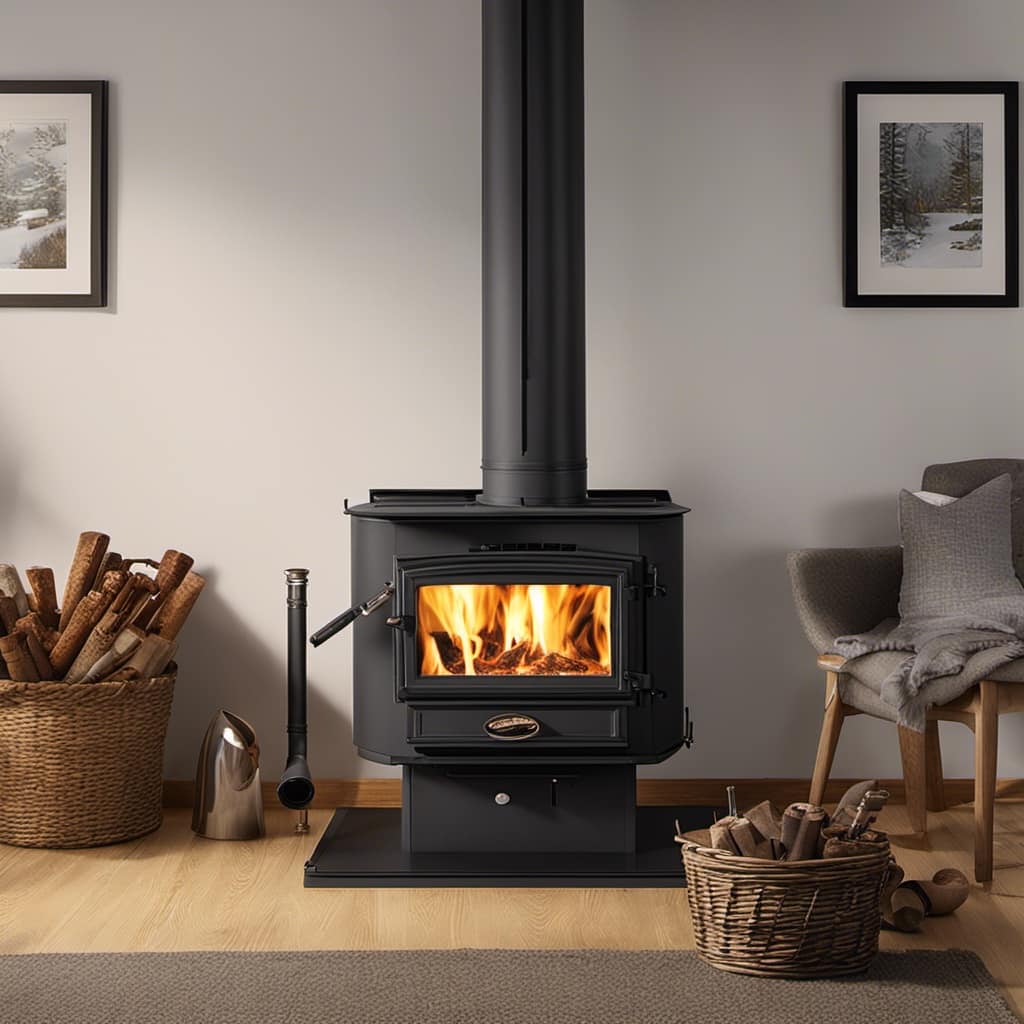
-
Glass Cleaning: The glass on the stove door should be cleaned regularly to maintain visibility and prevent soot buildup. I use a specialized glass cleaner to remove any stubborn residue.
-
Gasket Replacement: Over time, the gasket that forms a seal around the stove door may wear out. It’s important to check and replace this gasket if necessary to ensure proper combustion and prevent heat loss.
Safety Tips for Using a Wood Stove to Heat Your House
Using a wood stove for heating requires caution and awareness of potential safety hazards.
It’s important to be mindful of the carbon monoxide risks associated with wood stoves. Carbon monoxide is a colorless, odorless gas that can be deadly if inhaled in high concentrations. To prevent carbon monoxide poisoning, ensure proper ventilation by keeping windows cracked open and installing carbon monoxide detectors in your home.
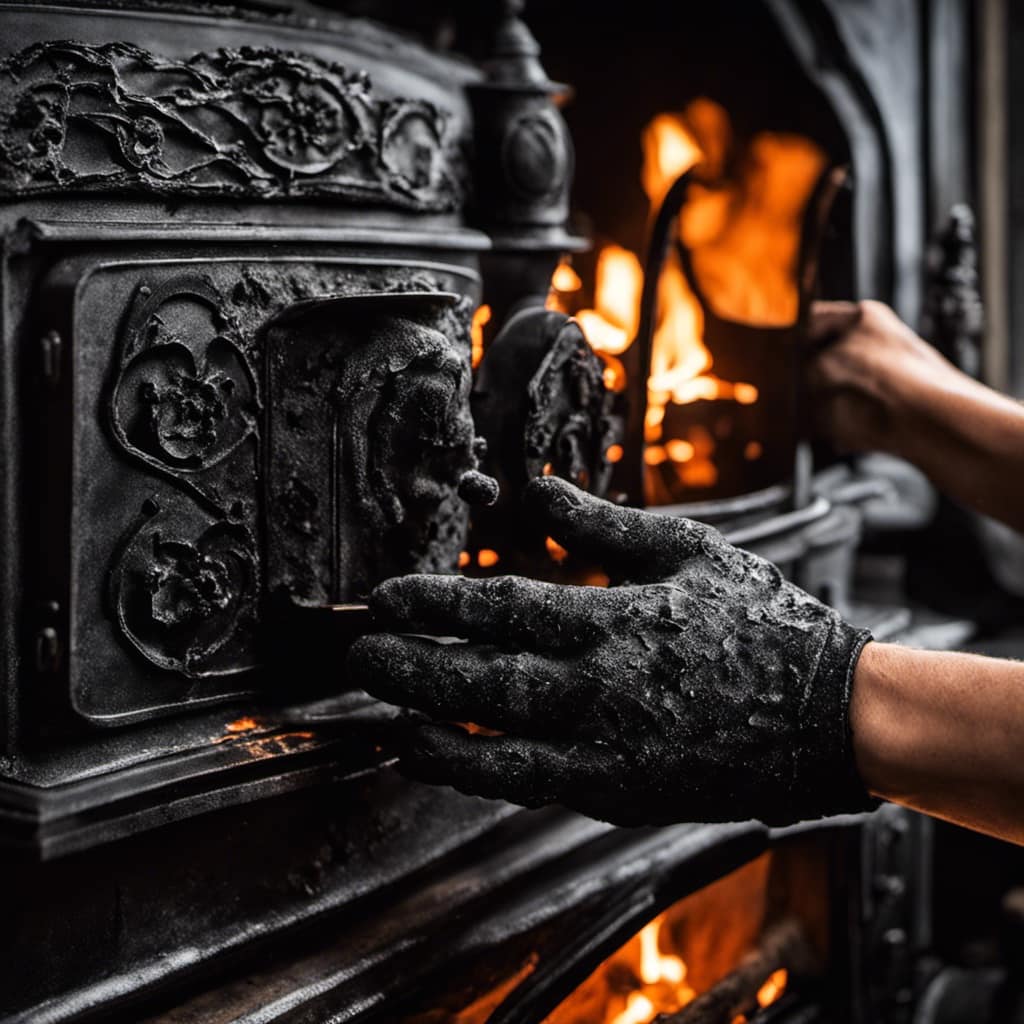
Additionally, chimney fires are a common hazard when using a wood stove. To prevent chimney fires, it’s crucial to have regular chimney inspections and cleanings to remove flammable creosote buildup. It’s also important to use dry and seasoned firewood to reduce the risk of chimney fires.
Frequently Asked Questions
Can I Use Softwood in My Wood Stove, or Should I Only Use Hardwood?
Using softwood in a wood stove has its pros and cons. Softwood ignites quickly and burns fast, providing immediate warmth. However, it produces more creosote, requires frequent cleaning, and may not provide long-lasting heat compared to hardwood.
How Do I Adjust the Temperature on My Wood Stove to Maintain a Comfortable Level of Heat in My House?
To maintain a comfortable level of heat in my house, I adjust the thermostat on my wood stove. By carefully monitoring and adjusting the temperature, I can ensure a cozy atmosphere throughout my home.
What Are Some Signs That Indicate My Wood Stove Is Not Getting Proper Ventilation?
When a wood stove doesn’t have proper ventilation, there are signs to look out for. These include excessive smoke, difficulty starting a fire, and a lack of heat production. To improve ventilation, ensure the chimney is clear and use proper air intake controls.
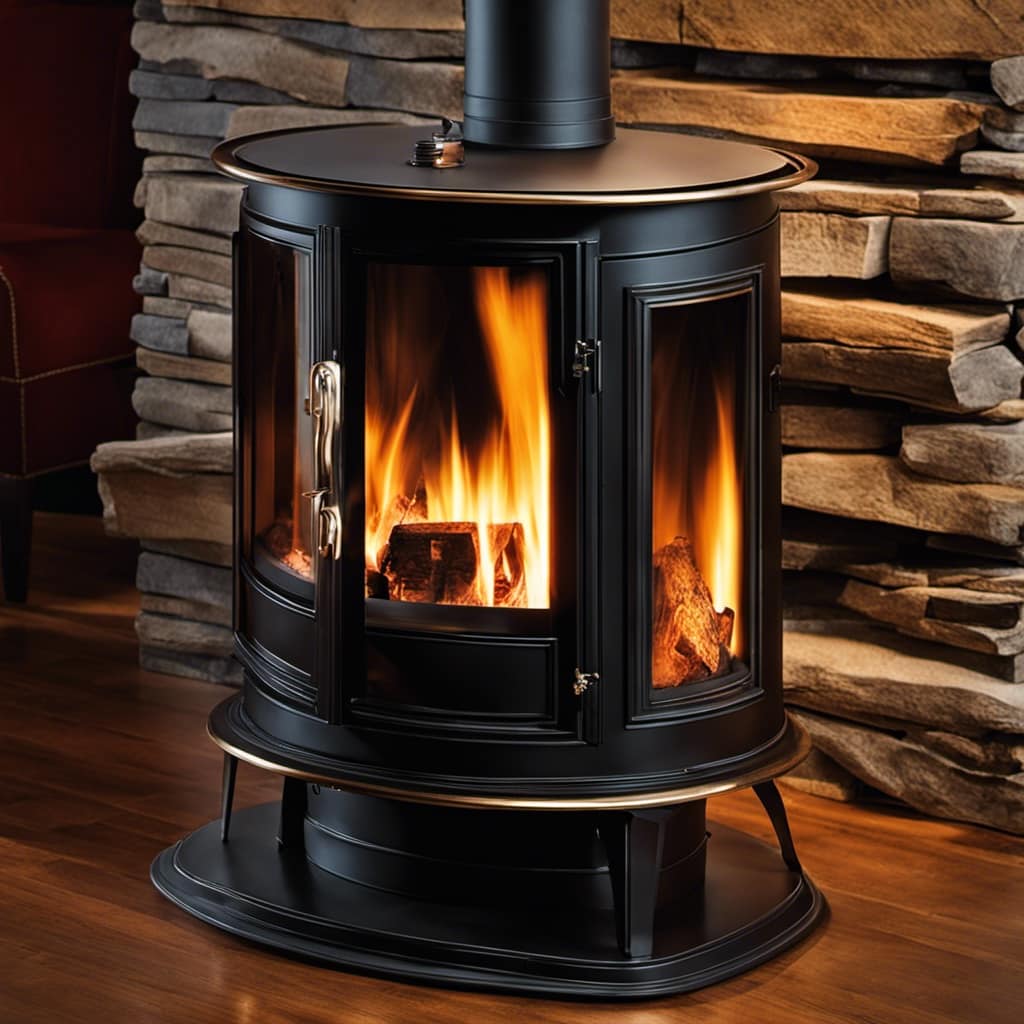
How Often Should I Clean My Wood Stove to Ensure Optimal Performance?
To ensure optimal performance, I clean my wood stove regularly. It’s crucial to maintain a comfortable level of heat in my house. Adjusting the temperature is simple, like turning a dial. As the adage goes, "Cleanliness is next to efficiency."
Are There Any Specific Safety Measures I Need to Take When Using a Wood Stove to Heat My House?
When using a wood stove to heat my house, I need to take specific safety precautions. Common mistakes include not properly ventilating the area, placing flammable items nearby, and neglecting to clean the stove regularly.
Conclusion
In conclusion, using a wood stove to heat your house can be a cost-effective and efficient way to stay warm during the colder months. By selecting the right wood, understanding temperature control, ensuring proper ventilation, and regularly maintaining and cleaning your stove, you can optimize its performance.
However, always prioritize safety by following the necessary precautions. Remember, ‘where there’s smoke, there’s fire,’ so keep a watchful eye on your wood stove to prevent any potential hazards.
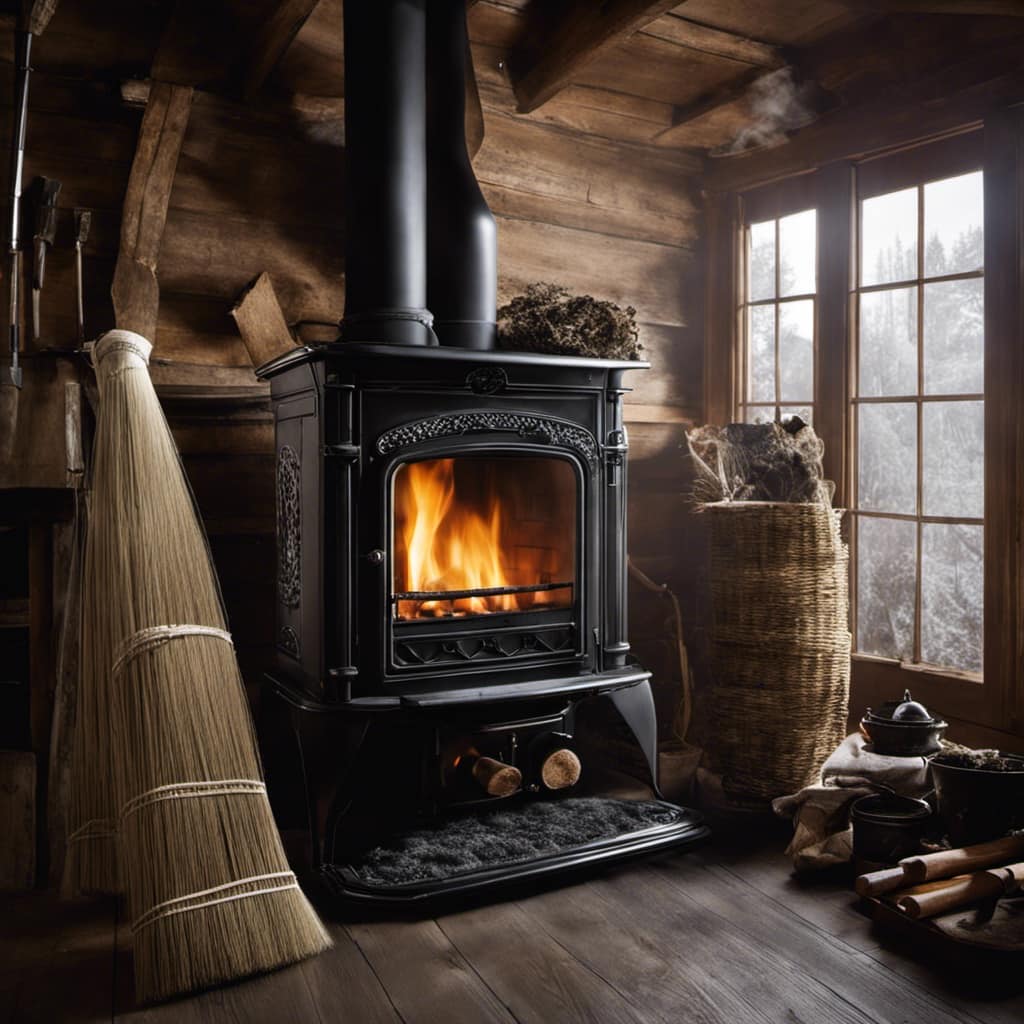
Stay warm and cozy!
Growing up surrounded by the vast beauty of nature, Sierra was always drawn to the call of the wild. While others sought the comfort of the familiar, she ventured out, embracing the unpredictable and finding stories in the heartbeat of nature.
At the epicenter of every remarkable venture lies a dynamic team—a fusion of diverse talents, visions, and passions. The essence of Best Small Wood Stoves is crafted and refined by such a trio: Sierra, Logan, and Terra. Their collective expertise has transformed the platform into a leading authority on small wood stoves, radiating warmth and knowledge in equal measure.




